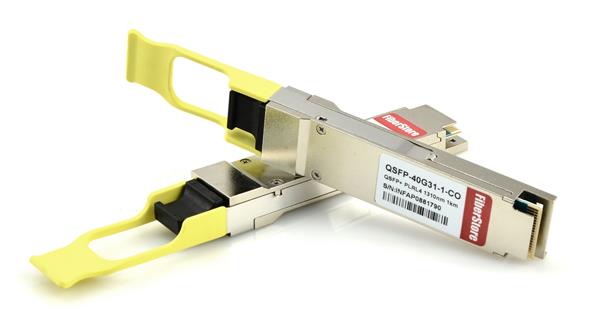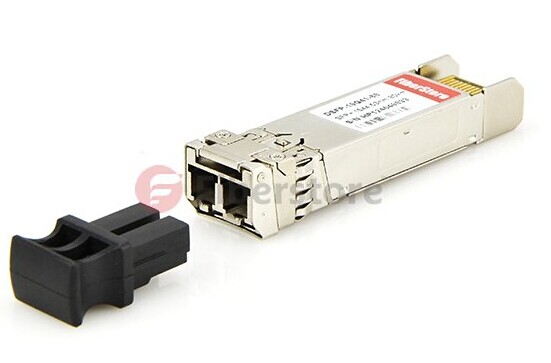Usually for single-mode fiber optic transceivers, the interface will be designed as LC duplex type. And for these optical modules, it will be easy to achieve structured cabling by using single-mode LC duplex infrastructure. But for 40G QSFP+, some single-mode transceivers do not follow this common rule. For example, 40GBASE-PLRL4 is a single-mode module supporting a transmission distance up to 1 km, but it has to be connected with an MTP/MPO-12 UPC connector. When migrating from 10G to 40G network using 40GBASE-PLRL4 modules, both single-mode LC duplex cable and single-mode MTP/MPO cable will be used. This article will take Arista QSFP-40G-PLRL4 and SFP-10G-LR optical modules as examples to explain several interconnect solutions for them.
Specifications of Arista QSFP-40G-PLRL4 and SFP-10G-LR
Arista 40GBASE-PLRL4 QSFP+ module is designed with a single-mode parallel MTP/MPO port. It can support a maximum link distance of 1 km on single-mode fiber operating at 1310nm wavelength. Arista 10GBASE-LR SFP+ module also has a single-mode port but its interface is LC duplex type. This SFP-10G-LR transceiver supports a long transmission distance up to 10 km over single-mode fiber operating at 1310 nm. Both of them support digital and optical monitoring.
Interconnect Solutions for Arista QSFP-40G-PLRL4 and SFP-10G-LR
In the first solution, a breakout cassette is used to move one 40G signal to four individual 10G signals. A 40G MPO cable is used on the QSFP-40G-PLRL4 side and four LC uniboot cables are connected to four SFP+s. The MTP/MPO equipment we used in this solution and the solutions below are all aligned as polarity B type.
Figure 1: interconnect for single-mode QSFP+ and SFP+ with MPO-12 to LC cassette.
The second connection is a very cost-effective solution for three QSFP-40G-PLRL4 to twelve SFP-10G-LR modules. Here the three breakout cables on the left are female MPO to 4xLC 8 fibers harness. Then by using two 6 LC duplex adapter panel, the three groups of 40G signals are divided into two groups that each has six 10G network devices. In this link, no fiber or port is wasted. Besides, it also allows flexible location of the QSFP+ modules, like in different chassis. By using customized bend insensitive single-mode LC duplex fiber patch cable, high performance transmission at longer lengths can be achieved.
Figure 2: interconnect for single-mode QSFP+ and SFP+ with MPO-8 to LC harness cable.
The next solution illustrated in figure 3 is a bit similar to the previous example in figure 2. It is also for three 40G parallel and twelve 10G duplex single-mode optical transceivers. But it is an application of MTP conversion harness cable and breakout patch panel. Here we used 3×8 strand MTP (female) to 2×12 strand MTP (female) single-mode conversion harness cable to connect the three QSFP+ transceivers to the 96 fibers 12xMTP/MPO-8 (male) to LC single-mode 40G breakout patch panel. Twelve LC uniboot patch cables are connected to the SFP-10G-LR transceivers.
Figure 3: interconnect for single-mode QSFP+ and SFP+ with 2×3 24-fiber MTP conversion harness cable.
The last interconnect solution is for two single-mode QSFP+ and eight SFP+ modules. Here another type of MTP conversion cable is used. It is a 2×12 strand MTP (female) to 1×24 strand MTP (female) single-mode conversion harness cable. A 24 fibers male MTP-24 to LC UPC duplex single-mode cassette is used to connect the MTP-24 connector and the eight LC duplex connectors. Low loss LC uniboot cables are again used for this high-density cabling.

Figure 4: interconnect for single-mode QSFP+ and SFP+ with 1×2 24-fiber MTP conversion harness cable.
Conclusion
This post introduced four interconnect solutions for single-mode parallel QSFP-40G-PLRL4 transceiver and single-mode duplex SFP-10G-LR transceiver. In order to meet different requirements, different equipment is deployed in different examples. Hope that these connections can be a guide for your single-mode network and can work well in specific applications.








